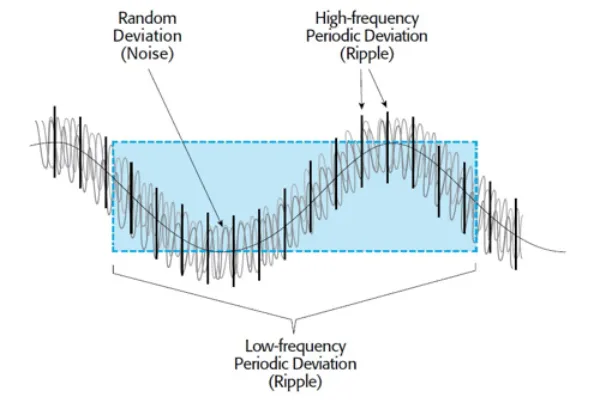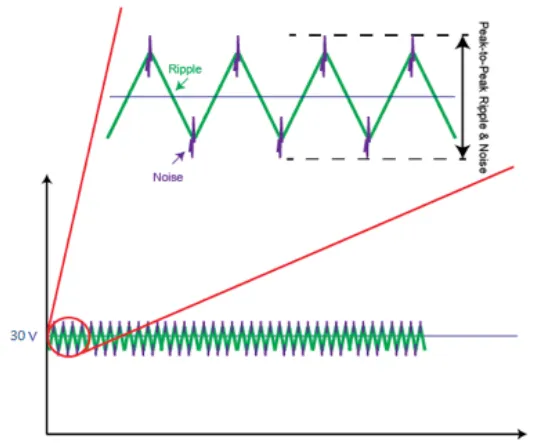What is LED Driver's Output Ripple and Noise?
The DC output of a LED driver can be identified as having an AC waveform, which can be further identified as Ripple and Noise (R&N) on the DC output. As a result of sine wave rectification, the first one has a low frequency that is 2 times the input frequency, while the second one has a high frequency that results from switching. as shown in Figure 1.  Figure 1. Component of AC form When energy is transferred from the primary to the secondary during a portion of the converter's operation cycle, the output voltage increases slightly. The load current is supplied by stored energy in the output capacitance and inductance of the converter during the times when no energy is transferred to the secondary, and the output voltage decreases slightly as this energy is depleted. As a low-frequency component, ripple will occur at the same frequency as the converter's operating frequency, or at a multiple thereof. Compared to ripples, noise is much more variable and difficult to predict. A switching converter generates ringing in parasitic inductances as a result of large values of di/dt that occur internally. Unlike ripples, noise has a much higher frequency and can reach up to MHz. As shown in Figure 2, noise occurs as "bursts" at the time of switching activity in the converter, therefore it appears to be superimposed on the peak and valley of the ripple waveform.
Figure 1. Component of AC form When energy is transferred from the primary to the secondary during a portion of the converter's operation cycle, the output voltage increases slightly. The load current is supplied by stored energy in the output capacitance and inductance of the converter during the times when no energy is transferred to the secondary, and the output voltage decreases slightly as this energy is depleted. As a low-frequency component, ripple will occur at the same frequency as the converter's operating frequency, or at a multiple thereof. Compared to ripples, noise is much more variable and difficult to predict. A switching converter generates ringing in parasitic inductances as a result of large values of di/dt that occur internally. Unlike ripples, noise has a much higher frequency and can reach up to MHz. As shown in Figure 2, noise occurs as "bursts" at the time of switching activity in the converter, therefore it appears to be superimposed on the peak and valley of the ripple waveform.  Figure 2. Output Ripple & Noise Note: The home station partial articles originate from the network
Figure 2. Output Ripple & Noise Note: The home station partial articles originate from the network
 Figure 1. Component of AC form When energy is transferred from the primary to the secondary during a portion of the converter's operation cycle, the output voltage increases slightly. The load current is supplied by stored energy in the output capacitance and inductance of the converter during the times when no energy is transferred to the secondary, and the output voltage decreases slightly as this energy is depleted. As a low-frequency component, ripple will occur at the same frequency as the converter's operating frequency, or at a multiple thereof. Compared to ripples, noise is much more variable and difficult to predict. A switching converter generates ringing in parasitic inductances as a result of large values of di/dt that occur internally. Unlike ripples, noise has a much higher frequency and can reach up to MHz. As shown in Figure 2, noise occurs as "bursts" at the time of switching activity in the converter, therefore it appears to be superimposed on the peak and valley of the ripple waveform.
Figure 1. Component of AC form When energy is transferred from the primary to the secondary during a portion of the converter's operation cycle, the output voltage increases slightly. The load current is supplied by stored energy in the output capacitance and inductance of the converter during the times when no energy is transferred to the secondary, and the output voltage decreases slightly as this energy is depleted. As a low-frequency component, ripple will occur at the same frequency as the converter's operating frequency, or at a multiple thereof. Compared to ripples, noise is much more variable and difficult to predict. A switching converter generates ringing in parasitic inductances as a result of large values of di/dt that occur internally. Unlike ripples, noise has a much higher frequency and can reach up to MHz. As shown in Figure 2, noise occurs as "bursts" at the time of switching activity in the converter, therefore it appears to be superimposed on the peak and valley of the ripple waveform.  Figure 2. Output Ripple & Noise Note: The home station partial articles originate from the network
Figure 2. Output Ripple & Noise Note: The home station partial articles originate from the network